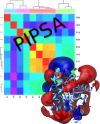

The python wrapper also allows analysis as described in
In case you want to restrict your analysis to a chain in your PDB entry, you need to edit your PDB entry file.
Open the file in a text based editor, search for lines like:
These intermediate results include grid files containing the electrostatic properties of the
protein in question. Please follow the link if you need assistance in
visualizing the electrostatic properties of a protein
Tong R, Wade RC, Bruce NJ.
Comparative electrostatic analysis of adenylyl
cyclase for isoform dependent regulation properties.
Proteins. 2016
Dec;84(12):1844-1858.
doi: 10.1002/prot.25167.
The python wrapper is also used in Jupyter Notebooks developed for the Human Brain Project. The respective notebookes can be found in the ebrains colab pages section 2.1 to 2.4 (you need to request an ebrains account).
Run commandline version in Google Colab
You can run the commandline version of PIPSA in a google colab. Please login to your google account,
visit the colab PIPSA in google colab, save a copy of the
notebook in your own google drive. First run the example case and then modify this to your needs.
webPIPSA
A walkthrough demonstration can be found here.
A PIPSA analysis allows the comparision of proteins with respect to their electrostatic properties.
Currently two different entry points exist for starting an analysis using webPIPSA (the webserver
implementation of PIPSA).
webPIPSA user guide for an analysis starting with PDB structures
Prerequisites
The standard PIPSA analysis requires protein structures as input data. These structures need to be
of a similar fold and may optionally be superimposed before upload.
A variant of the PIPSA workflow can be launched using a SWISSPROT accession code
as input. The related SWISSPROT entry needs to be an enzyme and annotated with an EC number.
Since for this workflow, a protein structural modelling is performed using MODELLER,
a license key for MODELLER is required. This workflow may be used to assist kinetic parameter
estimation by qPIPSA and is also integrated in SYCAMORE
(SYstems biology's Computational Analysis and MOdeling Research Environment). Additional information on
the qPIPSA workflow can be found in the respective user guide.
Performing a standard PIPSA analysis with webPIPSA
For the PIPSA analysis a set of proteins will be compared based on their electrostatic
properties.
How do I launch an analysis?
...
ATOM 4 O ASP A 47 8.935 1.466 32.973 1.00 19.12 O
ATOM 5 CB ASP A 47 12.150 1.716 32.915 1.00 17.85 C
...
The character after the amino acid code (ASP in the case above) states the chain identifier. Remove all
lines starting with "ATOM" that are not from the protein chain you want to analyse.
Calculation and results
If you encounter problems you may consult the demonstation page
or send an email to: mcmsoft@h-its.org.
Used tools
This webserver implements a workflow utilizing several commandline tools (not all may be used in a single workflow).
Here we acknowledge the use of the following scientific tools:
Tool Usage in webPIPSA Reference Details (eg. input parameters etc). BL2SEQ Used within the structural alignment protocol. Altschul, S.F., Gish, W., Miller, W., Myers, E.W. and Lipman, D.J. (1990) Basic local alignment search tool. J Mol Biol, 215, 403-410. WHATIF Used for adding polar hydrogen. Vriend, G. (1990) WHAT IF: A molecular modeling and drug design program. J. Mol. Graph., 8, 52-56.
UHBD One option for calculating electrostatic potentials. Madura, J.D., Briggs, J.M., Wade, R.C., Davis, M.E., Luty, B.A., Ilin, A., Antosiewicz, J., Gilson, M.K., Bagheri, B., Scott, L.R. et al. (1995) Electrostatics and diffusion of molecules in solution: Simulations with the University of Houston Brownian dynamics program. Comp. Phys. Comm., 1995. UHBD template input file PDB2PQR Preparation of APBS runs. Dolinsky TJ, Nielsen JE, McCammon JA, Baker NA. PDB2PQR: an automated pipeline for the setup, execution, and analysis of Poisson-Boltzmann electrostatics calculations. Nucleic Acids Research, 32, W665-W667 (2004). APBS One option for calculating electrostatic potentials. Baker, N.A., Sept, D., Joseph, S., Holst, M.J. and McCammon, J.A. (2001) Electrostatics of nanosystems: application to microtubules and the ribosome. Proc. Natl. Acad. Sci. USA, 98, 10037-10041. APBS template input file TCOFFEE Used for comparative modelling. 3DCoffee: Combining Protein Sequences and Structures within Multiple Sequence Alignments. O. O'Sullivan, K Suhre, C. Abergel, D.G. Higgins, C. Notredame. Journal of Molecular Biology,Vol 340, pp385-395,2004. CLUSTALW Used for comparative modelling. Chenna, R. et al. (2003): Multiple sequence alignment with the Clustal series of programs. In: Nucleic Acid Research. Bd. 31, S. 3497-3500. MODELLER Used for generating protein structural models from protein sequences and structural templates. Sali, A. and Blundell, T.L. (1993) Comparitive protein modelling by satisfaction of spatial restraints. J. Mol. Biol., 234, 779-815. PIPSA Comparison of electrostatic potentials. Blomberg, N., Gabdoulline, R.R., Nilges, M. and Wade, R.C. (1999) Classification of protein sequences by homology modeling and quantitative analysis of electrostatic similarity. Proteins, 37, 379-387. PHYLIP Produces a tree view available in the result directory. Felsenstein, J. 1989. PHYLIP - Phylogeny Inference Package (Version 3.2). Cladistics 5: 164-166. R-PROJECT Clustering of the output and drawing of heat map. Ihaka, R. and Gentleman, R. (1996) R: A language for data analysis and graphics. Journal of Computational and Graphical Statistics, 5, 299-314.